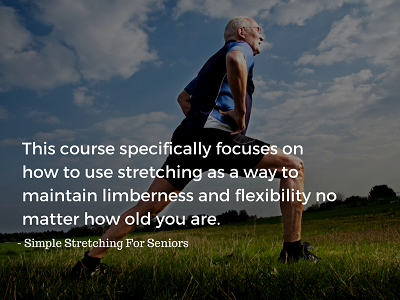 Any senior who is deciding to be proactive about stretching and increasing their flexibility is on the right track. However, before you start on your journey, it’s important to know where you currently stand.
Any senior who is deciding to be proactive about stretching and increasing their flexibility is on the right track. However, before you start on your journey, it’s important to know where you currently stand.
The only way to do that is to assess your level of flexibility before starting. This will not only give you an idea of how much progress you’ve made after a while, but you’ll also be aware of any limitation, weak spots or other issues that you should be aware of.
The first point to note is that generally, the older you are, the less flexible you’ll be. This is often the norm unless you’ve been engaging in regular yoga sessions throughout your life or you have a gymnastics training background and kept up with your flexibility training through the years.
Most seniors lead sedentary lives. So, it’s normal for one to be more rigid and inflexible due to age.
Health Inventory
Take a brief health inventory and ask yourself questions such as: Do you have back issues? Shoulder pain? Neck problems? Knee problems?
Knowing what health problems you have will allow you to work around them, or alleviate them. For example, if you have knee pain, doing hamstring stretches and hip stretches may relieve the pain. They may seem unrelated, but tight muscles in these areas can cause knee pain.
Check with Your Doctor
Speak to your doctor and check if you have any conditions that will limit your activities. For example, seniors with bad backs are often told not to engage in activities like gardening because of the strain it places on the back.
Any Stiffness?
Is there any part of you that feels stiff? Maybe you wake up every morning and your neck feels tight… or after sitting for a while stretching your legs may seem difficult. All these are hints given off by the body telling you that these areas need more attention and stretching.
Do a Few Simple Tests
Stand in front of a mirror and do a postural evaluation. Are you hunching? Are your shoulders drawn forward? Can you bend forward and touch your toes? If you can’t, how far can you go? Your forward flexion is a good indication of how flexible you are.
Do the same with a lateral flexion and extension. In other words, a side bend of your trunk and leaning backwards to see how far back you can go.
Are you able to clasp your hands behind your back? Can your head turn from side to side with maximum range of motion?
Ideally, you should have someone nearby to spot you. Since seniors may have balance issues, having someone by their side to help them out is an excellent idea.
Take Notes
It’s best to write down notes on your range of motion so that you have some record to measure your progress. For example, if you can only touch your knees when you bend forward, after 3 months of daily stretching, you may be able to touch your toes. That is definitely progress.
The same applies to other movements like trunk rotations, hamstring stretches and so on. You can only know how far you’ve come when you know where you used to be.
Once you embark on a stretching program, aim to do it 4 to 7 times a week. Stretching can be done daily. Over time you will see and feel the difference. Flexibility takes time, but with consistency, you will see results.






